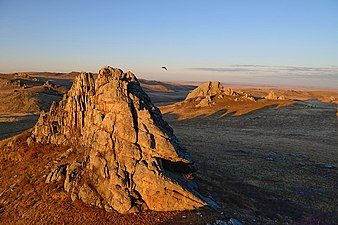
The region Transbaikalia (Забайка́льский край) has been in the Russian federal district since 2019 far East, before she belonged to Siberia. It borders the oblast in the north Irkutsk and the republic Sacha, in the west Buryatia, in the east to the oblast Amur and the neighboring country China, in the south to the Mongolia.
Regions

places
- 1 Chita
 - the largest city and capital of the region
- the largest city and capital of the region
- 2 Aginskoye the capital of Aginskoye Autonomous Region - Buryatia is a center of Buryat culture
- 3 Tschara - Gateway to the pristine and remote Kodar mountain region in the north of the Chita area, which has snow-capped mountains, the Chara sand dunes, numerous small, isolated Evenk villages and a former Stalinist gulag network; Accessible by plane or train from Chita or via the Baikal-Amur main line.
- 4 Nerchinsk - Founded in 1654, this city was the regional hub for China trade until it was surpassed by the new Chita railway in the late 19th century; a city steeped in history with some impressive architectural monuments in varying degrees of decay; there is also a 350-year-old monastery nearby, which marks the former location of Nerchinsk.
- 5 Petrovsk-Sabaikalsky
 - an old site of the decembrists in exile at the Trans-Siberian Railway
- an old site of the decembrists in exile at the Trans-Siberian Railway
- 6 Sabaikalsk
 - On the border with China you will pass through here if you travel on the Transmanjurian Railway.
- On the border with China you will pass through here if you travel on the Transmanjurian Railway.
Chita

Aginskoye

Nerchinsk

Petrovsk-Sabaikalsky

Sabaikalsk
Other goals
- 7 Darasun health resort - (Куро́рт-Дарасу́н) "Spa" is part of the Russian name. It is a balneological spa in a mountain valley.
- 1 Daurian nature reserve

- 2 Sokhondo Nature Reserve

- 3 Alkhanai National Park
 - on the southern flank of the Mogoitui Mountains
- on the southern flank of the Mogoitui Mountains

Daurian nature reserve

Sokhondo Nature Reserve

Alkhanai National Park
background
The Transbaikalia region was created through the merger of the Chita Oblast with the Agin Buryats Autonomous Okrug.
The Chita region resembles Buryatia in the great diversity and beauty of its landscapes. However, it is far less visited than its western neighbor. The Chita Oblast owes its importance to Russia primarily to its proximity to China. As such, it served as a starting point for international trade, migration, and even war. Today the Chita area has a large Russian military presence - for this reason Chita was a "closed settlement" during the Soviet era.
language
About 50 languages are spoken in Transbaikalia. The most common are Russian, Buryatsky, Ukrainian, and Belarusian.
getting there
By plane
By train
Chita is the main arrival point for most visitors, usually with the Trans-Siberian Railway although the main Baikal-Amur route also runs through the more remote north of Chita Oblast.
mobility
Tourist Attractions
activities
kitchen
nightlife
security
You should prepare for extreme climates, especially in winter you need suitable clothing to protect yourself against the cold. It is helpful, whenever possible, to use local sources of information to be warned of floods, forest fires, etc. There are forbidden areas that you should avoid as much as possible.
Nature is very pristine and represents a danger for the inexperienced. If you are in the forest, you should watch out for snakes, which usually warm up in the sun on the stones. There aren't many of them around, but some could be venomous vipers. The other problem these (and other regions of the Northern Hemisphere) have is ticks. Your bites may be infectious, vaccinations are recommended.
One should never stray further from human settlements without the appropriate equipment and leave the path, destination and intended period of the hike or rafting tour behind with every tour.
climate
literature
Web links
http://www.e-zab.ru/ - Official website of the Transbaikalia Region

.JPG/350px-Казанский_кафедральный_собор_(3).JPG)



.JPG/340px-Казанский_кафедральный_собор_(3).JPG)










.JPG/344px-Аэропорт_Чита_(1).JPG)